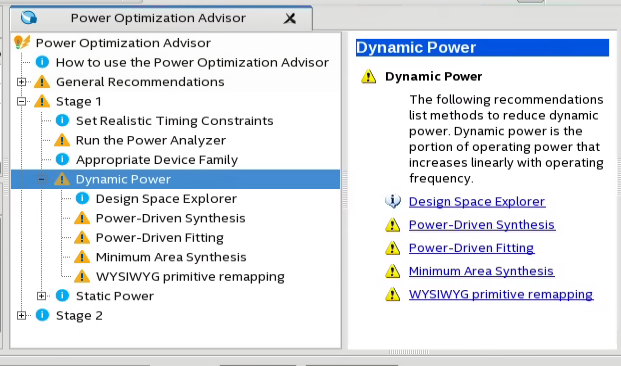Intel® Quartus® Prime Standard Edition User Guide: Power Analysis and Optimization
ID
683506
Date
9/24/2018
Public
Visible to Intel only — GUID: wag1532990554843
Ixiasoft
1.1. Comparison of the EPE and the Intel® Quartus® Prime Power Analyzer
1.2. Power Estimations and Design Requirements
1.3. Power Analyzer Walkthrough
1.4. Inputs for the Power Analyzer
1.5. Power Analysis in Modular Design Flows
1.6. Power Analyzer Compilation Report
1.7. Scripting Support
1.8. Power Analysis Revision History
1.4.2.1. Waveforms from Supported Simulators
1.4.2.2. .vcd Files from Third-Party Simulation Tools
1.4.2.3. Signal Activities from RTL (Functional) Simulation, Supplemented by Vectorless Estimation
1.4.2.4. Signal Activities from Vectorless Estimation and User-Supplied Input Pin Activities
1.4.2.5. Signal Activities from User Defaults Only
1.5.1. Complete Design Simulation
1.5.2. Modular Design Simulation
1.5.3. Multiple Simulations on the Same Entity
1.5.4. Overlapping Simulations
1.5.5. Partial Simulations
1.5.6. Node Name Matching Considerations
1.5.7. Glitch Filtering
1.5.8. Node and Entity Assignments
1.5.9. Default Toggle Rate Assignment
1.5.10. Vectorless Estimation
2.5.1. Clock Power Management
2.5.2. Pipelining and Retiming
2.5.3. Architectural Optimization
2.5.4. I/O Power Guidelines
2.5.5. Memory Optimization (M20K/MLAB)
2.5.6. DDR Memory Controller Settings
2.5.7. DSP Implementation
2.5.8. Reducing High-Speed Tile (HST) Usage
2.5.9. Unused Transceiver Channels
2.5.10. Periphery Power reduction XCVR Settings
Visible to Intel only — GUID: wag1532990554843
Ixiasoft
2.6.3. Dynamic Power
The recommendations in this section can reduce dynamic power.
Figure 33. Dynamic Power Recommendations in the Power Optimization Advisor

